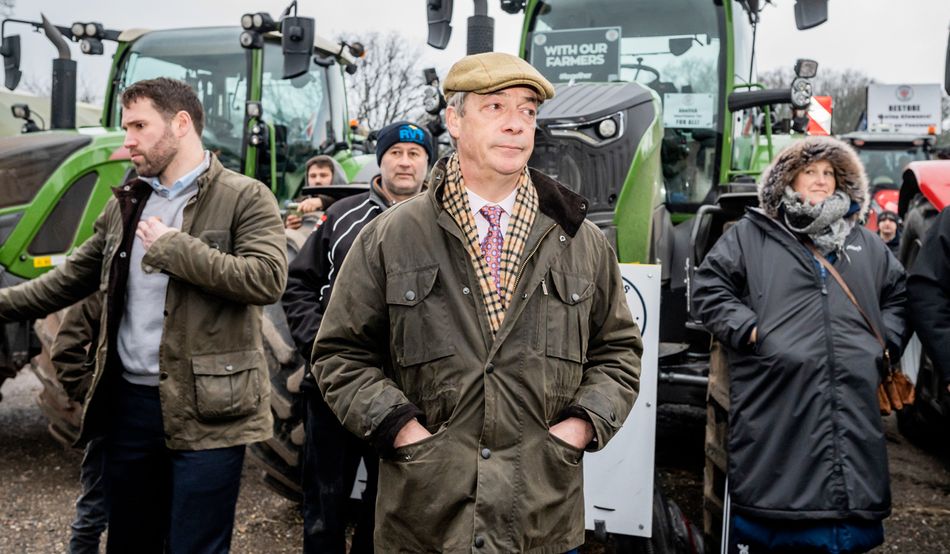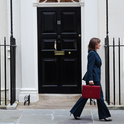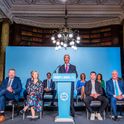Joining the protesters against the new inheritance tax laws affecting farmers in Westminster last November, the leader of Reform UK, Nigel Farage, wore a flat cap, checked shirt and tie, Barbour waxed jacket, mustard yellow corduroy trousers and green wellington boots.
At first glance, this is all easily decoded. Farage is communicating his support for rural communities by aping what country people wear. As all aspiring populist leaders must, he was demonstrating solidarity with stalwart folk of the countryside against the degenerate metropolitan elites that are about to inflict more pain on them.
But the day did not go well for Farage. He was rejected as a speaker at the rally because of his role in Brexit, with organisers declaring that they didn’t want to platform his sort of divisive rhetoric. Photographs show him looking rather disconsolate, plodding the not-so-wet streets of Whitehall between bodyguards and in wellington boots, with a furled black umbrella hanging from his right arm.
No farmer carries a black umbrella, even in London, and the sight of it prompted me to look more closely at his outfit that day. Of course, it was all wrong. Farmers prefer the practical, elastic-sided “dealer” boots to wellingtons, tend to opt for fleeces and hardwearing waterproofs over Barbour jackets, and are just as likely to sport a US-style peaked baseball hat as a flat tweed cap. Also, a tie is a rare thing in the countryside, even at agricultural shows and seasonal livestock sales. There are few absolute rules, but you can be certain that no working farmer would be seen dead in Farage’s bright yellow trousers.
I assumed Farage would be one for the Savile Row tailor, but I soon realised that he is a ready-to-wear man
Reform’s leader had dressed in an idea of the country, confusing “county wear” with ordinary, everyday countryside clothes, the former being the apparel that middle-class city people choose to conjure country life but often overdo and end up looking a little absurd. Farage responded to a day of protest and rural anxiety in Westminster by dressing as if he were attending the Badminton horse trials or the Easter Monday point-to-point race. His clothes did not, in any way, reflect country life as it is led by farmers who are protesting the inheritance tax levy on assets worth more than £1m.
The outfit was a parody, and betrayed the truth that Farage has spent most of his life in London and its suburbs. But this doesn’t matter, because he is aiming at a public that is unconcerned with the detail or flashes of his dandyish vanity. What people see are the instantly identifiable symbols of Farage as a countryman and champion of the countryside. The same goes for the sober tweed sports jacket, checked shirt and tie that he wears when campaigning. These have become as much his brand image as the pint held up to the camera and the grin spreading across that enormous, insectivorous mouth.
But there’s more than simple image-making going on here. Clothes mean a lot to Farage. His biographer Michael Crick reveals that he took infinite pains over his army cadet uniform at Dulwich College, that he disliked muddying his football kit and sometimes appeared with a cane and snuff box. I assumed this fastidiousness would mean that Farage would be one for the Savile Row tailor, but on my tour of gentlemen’s outfitters online and in the West End I soon realised that he is a ready-to-wear man—and quite a prodigious shopper.
Of the three summer jackets he uses, I found two online. The “Mazelli” pink tweed check he wore on his way back to the UK after appearing on I’m a Celebrity Get Me Out Of Here and in interviews before last year’s general election can be obtained from Brocklehurst (“the best country clothing in the country”) for £350. The blue-and-white striped linen blazer that he sports for parties and boating publicity stunts is almost certainly from Hackett and costs £540. It was a shame I couldn’t source the double-breasted royal blue blazer with silver buttons, because it’s the quintessential look of the bounder.
I visited Hackett, Harvie and Hudson, New and Lingwood in Jermyn Street and Cordings of Piccadilly. Farage would do very well as a window mannequin in all three—garish trousers, checked shirts, caps, ties with game bird motifs and tweed jackets are all for sale in these stores. I was drawn to a buff, lightweight “covert” coat in -Cordings, a version of which -Farage owns, and recalled how my father, a fifth-generation army officer, wore one at National Hunt race meetings with a way-too-small trilby. As if -reading my reverie, an assistant approached to tell me that Cordings was favoured by -military gentlemen who wanted to dress “appropriately”.
Farage appears always to be striving for appropriateness and, therefore, I guess, acceptance. I have no idea whether this former public schoolboy is socially insecure, but his attention to proper form indicates that he might be. And yet, to purchase the standard covert with an olive velvet collar, which he did, will be regarded as a solecism by the very people from whom he wishes to win acceptance.
The yearning for correctness is not the whole story. Farage’s clothes transmit messages about his conventional values and trustworthiness, which are designed to reassure people that he isn’t a threat. It’s worth noting that the man who is -trying so hard to channel the vibes of a country auctioneer or reliable, old-fashioned vet, like Robert Hardy’s -character in the old TV series of All -Creatures Great and Small, can’t say whom he admires more—Putin or Trump. The man -channelling the kind of tweedy doctor I recognise from my rural youth is the one who wants to do away with the NHS and open supermarket aisles to chlorinated chicken.
The distance between self-respect and vanity is never far in a politician with Farage’s level of ambition
When, as an 18-year-old student, I worked as a waiter in a restaurant in a provincial Italian city, we were often joined by a middle-aged man who was impeccably turned out for the evening passeggiata, or parade, on the city’s main thoroughfare. He wore a lovely suit, shirt and tie, and always had perfectly coiffed hair. He looked upon my long hair, jeans and T-shirt with sadness, and after several encounters explained that the fundamental difference between the way he and I dressed was in “rispetto di sé”. The care he lavished on his appearance displayed his self-respect. That was the point.
So, what’s the problem if Farage is simply displaying his self-respect? More British men could surely benefit from his example, particularly our drab male politicians. The difficulty with this is that the distance between self-respect and vanity is never far in a politician with Farage’s level of ambition. Perhaps his parading around in pink jackets and yellow cords is indicative of a self-love that, if he ever acquires power, would be disastrous for the United Kingdom. But more important than the vanity is the calculated dishonesty in Farage’s sartorial choices. His wardrobe masks the extreme and destructive nature of his views, which you only understand if you watch his speeches in full on YouTube.
Farage did eventually manage to address protesting farmers. In February, he spoke at a rally held as a collaboration between two right-wing groups, Together Declaration and Farmers to Action, the latter of which was cofounded by an activist, who describes himself as having a background in hospitality, named Tarquin de Meza. This connection may explain how Farage won his platform in the countryside despite the fact that most farmers understand that Brexit has been a disaster for them, resulting in the reduction of subsidies, the loss of access to our nearest market and the introduction of competition from Australia and New Zealand.
For the occasion, Farage jettisoned the yellow corduroys and green wellingtons to make a speech in a flat cap and waterproof jacket. It won little coverage, which was a shame because in a few short sentences you saw the real Farage. He promoted the right-wing conspiracy theory that the government was attacking farmers so that it would have land to bring in five million more immigrants and “cover tens of thousands [of acres] of grade-one agricultural land in places like Lincolnshire with solar panels”.
Then, this child of the suburbs and the city concluded by implying that he was the countryside’s only real friend, saying that the “political class in Westminster had no connection to or understanding of rural communities or what they represent”. He suggested that “maybe you’re not diverse enough”.
So, this wasn’t about the stresses facing farmers after all, but a rant about immigration, net zero and diversity. No amount of tweed or the flat cap he wore for the speech will disguise the agenda of an urban political chancer who is now making a run for around 100 rural and semi-rural seats held by Labour.














